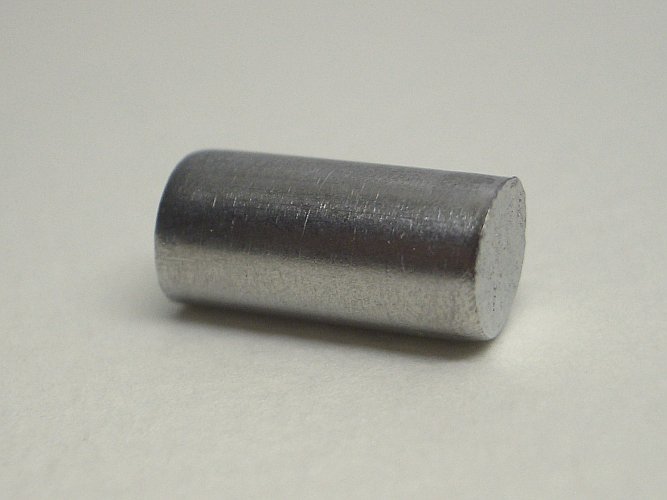


Zirconium and hafnium
 The metals zirconium and hafnium resemble the metal titanium,
both physically and chemically. They are silvery grey metals, which are very corrosion
resistant in the massive state. The chemical difference between hafnium and
zirconium is so small, that for a long time, the metal hafnium was not known.
Even up to now, it is very difficult to isolate hafnium from zirconium.
Commercial technical grade zirconium samples contain several percents of
hafnium. The picture, shown here, shows a sample of 99.8% zirconium.
The metals zirconium and hafnium resemble the metal titanium,
both physically and chemically. They are silvery grey metals, which are very corrosion
resistant in the massive state. The chemical difference between hafnium and
zirconium is so small, that for a long time, the metal hafnium was not known.
Even up to now, it is very difficult to isolate hafnium from zirconium.
Commercial technical grade zirconium samples contain several percents of
hafnium. The picture, shown here, shows a sample of 99.8% zirconium.
The metals in the massive state are remarkably inert. Even hot concentrated mineral acids are not capable of dissolving the metals at a reasonable rate. The metals also are not attacked by concentrated alkalies. Only hydrofluoric acid is capable of dissolving the metals at a higher rate, because of formation of hexafluoro-metallate (IV) complexes.
As with titanium, when the metal are finely powdered, they become more reactive. Ultrafine powders of these metal can even be pyrophoric.
Where titanium still has, although somewhat limited, aqueous chemistry for the +3 oxidation state, the metals zirconium and hafnium do not have such chemistry at all. The oxidation state +3 is too strongly reducing for these metals to be stable in water.
The elements can be obtained from eBay from several suppliers. They, however, are quite expensive in the pure state. Given their inertness, limited aqueous chemistry and relatively high price, these metals can be regarded as not very interesting for the home lab.
![]()
The aqueous chemistry of oxidation state +4 also is fairly limited for these two metals, due to extreme hydrolysis. Any zirconium or hafnium compound, which is soluble in water, immediately is converted to the hydrous metal oxide and an acid.
A fairly cheap zirconium compound is the white powder ZrO2, which can be obtained from ceramics and pottery suppliers. However, this compound also is not interesting for the home lab, due to its extreme inertness. Only with great difficulty, some of this can be dissolved in concentrated hot acids or concentrated hot alkalies.